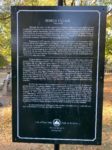 One hundred and sixty-two years after the predominately African-American residents of Seneca Village were literally beaten out of their homes by New York police, the great urban park that was built over the once-thriving community has finally given it long-overdue attention. Plaques marking significant locations of the site have been installed inside Central Park as part of a new Discover Seneca Village exhibition.
One hundred and sixty-two years after the predominately African-American residents of Seneca Village were literally beaten out of their homes by New York police, the great urban park that was built over the once-thriving community has finally given it long-overdue attention. Plaques marking significant locations of the site have been installed inside Central Park as part of a new Discover Seneca Village exhibition.
Seneca Village was founded in 1825 by free African-Americans in what was the farmland miles away from downtown Manhattan. Slavery was still legal in New York state. Full emancipation was two years away, but even then systems were in place to deprive black people of the rights of citizenship. For an African-American man to be allowed to vote, he had to own at least $250 worth of property and have resided in the state for three years. When Seneca Village was formed out of farmland lots stretching from W82nd to 88th Streets between Seventh and Eighth Avenues, therefore, those lots meant much more than simple home ownership. In 1855, only 100 black men qualified for the vote in New York. Ten percent of them lived in Seneca Village.
The community became ethnically mixed with influx of Irish and German immigrants in the 1840s. Seneca Village had a population of less than 300 when the New York legislature decided to build a city park and authorized taking the land by eminent domain. More than 1,600 people were forced to sell their property and moved out to make way for Frederick Law Olmsted and Calvert Vaux landscaped urban paradise. The Senecans went to court to keep their homes, fighting for two years until they were violently removed in 1857.
The construction of Central Park and New York’s short memory quickly erased the existence Seneca Village. It has only been revived in recent decades thanks to the 1992 publication of a book about the history of Central Park and the sustained efforts of historians, researchers and archaeologists culminating in the first excavation of the site of the village in 2011.
“The Institute for the Study of Seneca Village History has been studying Seneca Village for decades, through archeological excavations as well as research about the community and its descendants. This exhibit of signage will be a valuable way for the public to begin to explore the history of this extraordinary community, which is still not widely known, and to inspire discussion about its meaning today,” founders of the Institute for the Exploration of Seneca Village History said in a statement.
Sites highlighted by the new plaques include Seneca Village’s significant gardens, churches, homes and infrastructure. Several plaques also detail what life was like for Seneca Village residents, including the significant Irish-American community that made up about one third of the village’s residents. The conservancy plans to keep the signage on exhibit through October 2020.
The new signs are not permanent; they are part of an outdoor exhibit dedicated to Seneca Village, its critical importance in the history of slavery, emancipation, African-American and immigrant life in New York city in the first half of the 19th century. To take a walk through the Seneca Village exhibition in Central Park, start at the West 85th Street entrance. A map marking the significant sites will lead you through 16 key locations explained by the signs at every stop. (A pdf of the map can be downloaded here.)
Edit: I cannot believe I didn’t post this yesterday. Two calendar gaps in one month!1 I can’t even blame the scheduling system this time. I just plum neglected to mash the button like an idiot.

Great GIF. Is that part of Cersei Lannister’s walk of shame?
So, I am correct that these signage will be up for about a year and then nothing? After decades of research? The systemic racism is outrageous. Nothing has really changed. So many communities have been destroyed, and cultures, by imminent domain, and here was an opportunity to make a difference, but for only a year. Shame multiplied.
The systemic virtue signaling has reach a new pinnacle! Hurrah!